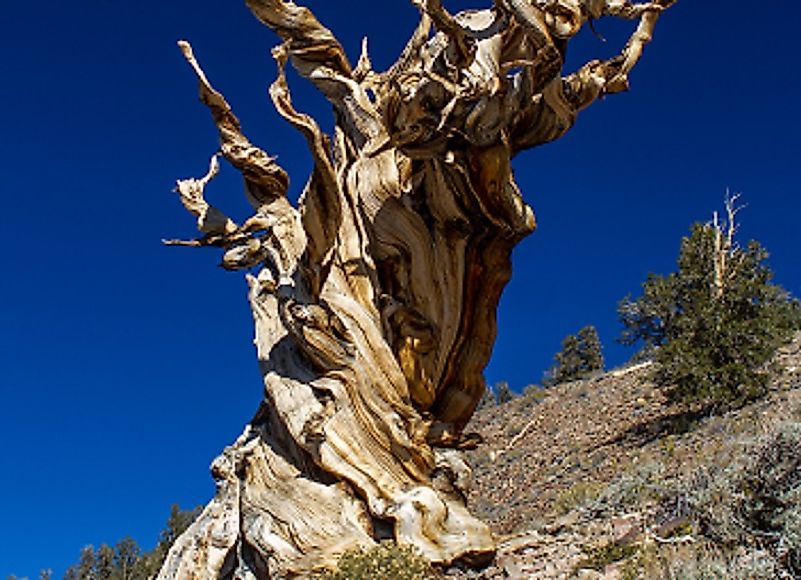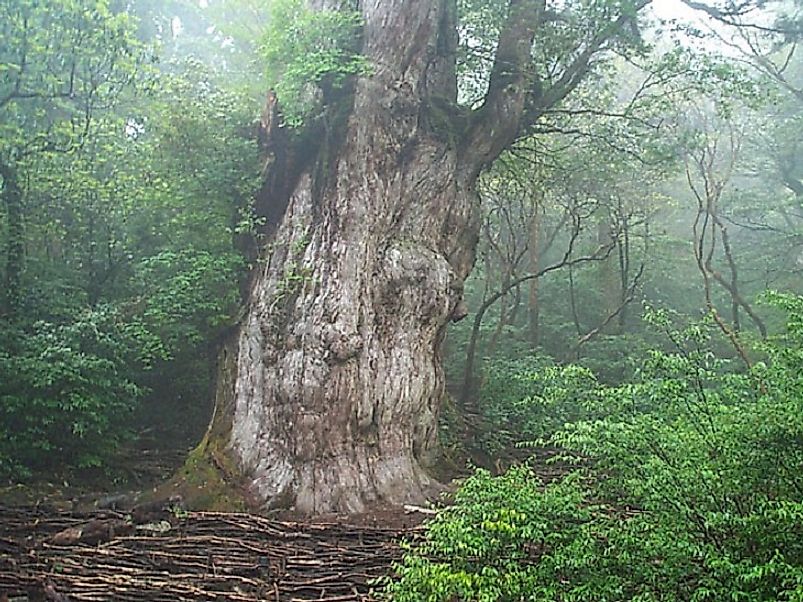Oldest Living Trees On Earth

Dendrochronology was pioneered in large by Andrew Ellicott Douglass and his followers in the decades since at the University of Arizona's Tree Ring Research Laboratory. The discipline uses tree growth rings to date trees, and the aforementioned institute and its affiliated subject matter expert researchers have dated many of the trees to make this list. Some species are especially well known for their longevity, such as certain yews, Bristle-cone pines, sequoias, and Yaku Sugi cryptomeria trees.
11. Sequoia CMC 3, Sierra Nevada, CA, USA (3,033 years old)
Giant Sequoia trees grow on the western side of the Sierra Nevada mountains in California. They thrive in elevations between 5,000 and 7,000 feet. Sequoia CBR26, D-21, D-23, and CMC 3 are all unfortunately dormant today, though many other Giant Sequoia trees continue to live in the California mountains. Although some reside in government-protected lands, the majority live in unprotected private land, and thus could theoretically be cut down at any point. Many lobbyist groups are pushing to expand Federal control of this land to protect these ancient trees. Sequoia CMC 3 was dated by University of Arizona tree ring researchers Tom Swetnam and Chris Baisan in the 1990s.
10. Sequoia D-23, Sierra Nevada, CA, USA (3,075 years old)
In 1919, American astronomer and dendrochronologist Andrew Ellicott Douglass listed this tree in his publication, Climatic Cycles and Tree Growth: Vol. 1. A Study of the Annual Rings of Trees in Relation to Climate and Solar Activity.
9. Sequoia D-21, Sierra Nevada, CA, USA (3,220 years old)
Andrew Ellicott Douglass also listed this tree in the aforementioned publication detailing the age of Sequoia D-23. Douglass was a founding father of dating wood via tree ring research (dendrochronology). He worked extensively with the Carnegie Institute, the National Geographic Society, and the University of Arizona to further the work of this burgeoning field. The University of Arizona tree ring research program he founded in the 1930s is still one of the most important in this field of study today.
8. Sequoia CBR26, Sierra Nevada, CA, USA (3,266 years old)
Sequoia CBR26 was date by University of Arizona tree ring researchers Malcolm Hughes, Ramzi Touchan, and Ed Wright in the 1990s.
7. Alerce Milenario Fitzroya cupressoides, Alerce Costero, Los Rios Region, Chile (3,622 years old)
The Alerce is an increasingly rare breed of conifer that only grows in Argentina and Chile. Charles Darwin named the species himself, naming it Fitzroya cupressoides after the captain of his ship. The Alerce Milenario is the oldest of these trees, located in a Chilean national park established in 1987. Chile established this park and a few others to protect the Alerce trees, which were being rapidly deforested due to their wide range of uses. Although cutting them became illegal in 1976, some merchants continue to chop them illegally.
6. Fortingall Yew, Perthshire, Scotland (~4,000 years old)
The Fortingall Yew in Scotland has showed up in British newspapers recently, as scientists have discovered it is “changing sex.” Yew trees, unlike most trees, have very clearly defined genders. This tree has historically been male, producing only pollen, but recently scientists discovered a branch that had produced berries as well, a characteristic usually specific to female trees. Such a change is uncommon, yet, not impossible among most conifer trees, including yews. Nonetheless, scientists cannot yet explain this phenomenon. Local legend says that Roman prefect Pontius Pilate of Biblical lore was born beneath this very same tree.
5. Llangernyw Yew, Llangernyw, Conwy, North Wales, Wales, UK (~4,500 years old)
The Llangernyw Yew can be found in the small yard of St. Dygain’s Church in northern Wales. Dating yew trees is notoriously difficult, as their rings tend to rot away as they continue to grow, but most scientists estimate this tree to be between 4,000 and 5,000 years old. In 2002 it was named as one of the 50 Great British Trees. This ancient tree plays a role in Welsh mythology as well. Legend says that every Halloween the tree, known as the Angelystor or “Recording Angel,” will speak the names of all the people who will die before the next Halloween comes.
4. Prometheus, Wheeler Park, NV, USA (4,844 years old)
The Prometheus tree gave its life for science in 1964, when researchers cut it down to analyze the age and workings of bristle-cone pines. The scientists who chopped down Prometheus did not realize how old it was until they had already cut it. This tree gets its name from a Greek myth. Prometheus was an immortal being who was said to have given fire and knowledge to men.
3. Methuselah, White Mountains, CA, USA (4,845 years old)
Methuselah was named after the oldest man recorded in the Bible, who lived to be 962 years old. Even so, Methuselah the tree has far outlived Methuselah the man. In fact, it sprouted even before the Egyptian pyramids were built! Methuselah is a bristle-cone pine, a type of tree known for living in high elevations and harsh weather conditions. Bristle-cone pines can live for so long because they spread their roots incredibly far to soak up as many nutrients as possible, and because they can “go dormant” in years of low rainfall and then return back to normal life cycles when conditions become more conducive. Methusaleh was dated by Ed Schulman and Tom Harlan of the University of Arizona's Laboratory of Tree Ring Research.
2. Jomon Sugi, Japanese Cedar, Yakushima, Japan (~5,000 years old)

The Jomon Sugi tree is part of a group of ancient Japanese cryptomeria trees which grow on the island of Yakushima. As a group, they are known as Yaku Sugi trees. These trees grow slowly due to the high levels of rainfall and low levels of nutrition provided by the soil in the region. Because of these harsh conditions, they are incredibly durable, and those that withstand the climes can live to be quite old. Yaku Sugi trees protect themselves against unforgiving weather by building up high amounts of resin, which shields their respective trunks from the onslaught of disease and decay. Unfortunately, this feature makes them especially suitable for building weather-hardy houses, so many of them have been cut down.
1. Pinus longaeva, White Mountains, CA, USA (5,062 years old)
Discovered in 2013, this tree is known by its species' specific epithet, Pinus Longeava, because as an individual it has not been officially named yet. This tree is also a bristle-cone pine, and is known for its gnarled appearance. The bristle-cone pine earned its name for the dark purple cones it produces, which are covered in small prickles. Like Methusaleh, this White Mountains' specimen was dated by Ed Schulman and Tom Harlan of the University of Arizona's Laboratory of Tree Ring Research.











